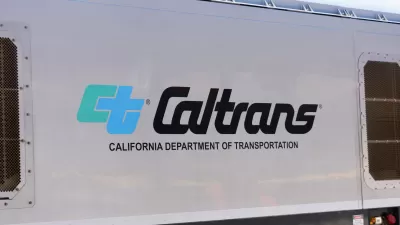New research by Ewing et al finds that vehicle miles traveled in LEED-ND projects may be as much as 60% lower than regional averages. However, objective models of transportation outcomes may prove more efficient than LEED’s points-based system.
In this new series, Journal of Planning Education and Research (JPER) articles will be made available to Planetizen readers subscription free for 30 days. This is possible through collaboration between SAGE Publications and the American Collegiate Schools of Planning. JPER is currently edited by Subhro Guhathakurta and Nancey Green Leigh of the Georgia Tech School of City and Regional Planning.
Sprawling residential developments dominate the American suburbs. Such car-dependent landscapes separate uses, disconnect street-networks, contribute to unhealthy sedentary lifestyles, and may exacerbate global warming by encouraging driving for even the most trivial of chores. Many policy makers view the US Green Building Council’s LEED-ND system for sustainable neighborhood development certification as an industry-driven solution to the hegemony of the “cul-de-sac,” while other’s doubt the private sector’s ability to impact problems as complex as sprawl. Others note that the LEED-ND point system is complex and subjective.
With this in mind, Reid Ewing et al assess the impact of LEED-ND certified neighborhoods on driving and transportation habits. To do this, the authors compared LEED-ND projects to 239 MXDs (Mixed Use Developments) of various sizes, designs, and locations in six regions (Atlanta, Houston, Boston, Sacramento, Portland, and Seattle) about which the U.S. EPA has collected transportation data regarding Vehicle Miles Traveled (VMT), walking, and transit use.
LEED-ND’s certification system is points based and mixes elements of “smart growth, New Urbanism, and green building” (266). Points are awarded for location efficiency, street connectivity, sidewalks, mixing of uses, stormwater practices; just to name a few of the evaluative categories (for more details see the article or USGBC). Projects are eligible for LEED-ND bronze, silver, gold, and platinum certification.
The authors are part of a school of thought in transportation planning that attempts to explain transportation choices through their relationship to a series of Ds:
The original three Ds, coined by Cervero and Kockelman (1997), are density, diversity, and design, followed later by destination accessibility and distance to transit (Ewing and Cervero 2001). Development scale is a sixth D, relevant to analyses where the unit of analysis is a development project. While not part of the environment, demographics are the seventh D, controlled as confounding influences in travel studies. (267).[1]
The authors estimate transportation outcomes by hierarchical multilevel statistical modeling (270) in order to establish the “probability of walk trips, probability of transit trips, and length of trips by automobile” (269) in a given development. These probabilities then formed the basis of analysis of 12 LEED-ND projects based on their own composition of the 7-Ds. The authors then compared the LEED-ND projects to regional averages for the MXDs for which the EPA collected travel data. Their models predict that VMT reductions may be “from 24 to 60 percent of the respective regional averages” and that urban projects will receive significant bumps in walking and transit trips.[2]
These finding have potential impact in validating LEED-ND. Ewing and his co-authors also argue that the LEED-ND system could be simplified based on their methodology to use predicted VMT, and trip mode outcomes, from the 7 Ds as one of the principle methods of accessing eligibility. Such a shift in evaluation would reduce dependence on the current subjective point system, leading the Ewing et al to conclude that the “objective predictions performed in this study should become central to the LEED certification process.”
Reid Ewing, Michael J. Greenwald, Ming Zhang, Meghan Bogaerts, and William Greene. 2013. Predicting Transportation Outcomes for LEED Projects. Journal of Planning Education and Research 33(3) 265–279.
Summary by Tom Douthat
SAGE and ACSP have kindly granted access to the full article until 11/11/2013
[1] See article for citations.
[2] The authors note that the sample size for this study is small, and that data limitations may confound some of the findings (277-278).

Alabama: Trump Terminates Settlements for Black Communities Harmed By Raw Sewage
Trump deemed the landmark civil rights agreement “illegal DEI and environmental justice policy.”

Study: Maui’s Plan to Convert Vacation Rentals to Long-Term Housing Could Cause Nearly $1 Billion Economic Loss
The plan would reduce visitor accommodation by 25% resulting in 1,900 jobs lost.

Planetizen Federal Action Tracker
A weekly monitor of how Trump’s orders and actions are impacting planners and planning in America.

Waymo Gets Permission to Map SF’s Market Street
If allowed to operate on the traffic-restricted street, Waymo’s autonomous taxis would have a leg up over ride-hailing competitors — and counter the city’s efforts to grow bike and pedestrian on the thoroughfare.

Parklet Symposium Highlights the Success of Shared Spaces
Parklets got a boost during the Covid-19 pandemic, when the concept was translated to outdoor dining programs that offered restaurants a lifeline during the shutdown.

Federal Homelessness Agency Places Entire Staff on Leave
The U.S. Interagency Council on Homelessness is the only federal agency dedicated to preventing and ending homelessness.
Urban Design for Planners 1: Software Tools
This six-course series explores essential urban design concepts using open source software and equips planners with the tools they need to participate fully in the urban design process.
Planning for Universal Design
Learn the tools for implementing Universal Design in planning regulations.
Caltrans
Smith Gee Studio
Institute for Housing and Urban Development Studies (IHS)
City of Grandview
Harvard GSD Executive Education
Toledo-Lucas County Plan Commissions
Salt Lake City
NYU Wagner Graduate School of Public Service






























